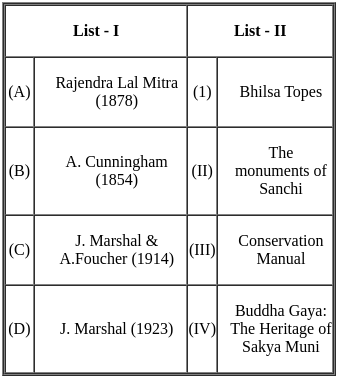History: CUET Mock Test - 3 - CUET MCQ
30 Questions MCQ Test - History: CUET Mock Test - 3
Which ancient civilisation yielded remains of a Mauryan circular stupa-shrine made of lime-plastered panels?
Arrange the different stages of the discovering of Amaravati in a chronological order:
(A) In 1854, Walter Elliot visited Amaravati and collected several sculpture panels.
(B) The slabs from Amaravati were taken to different places like the India Office in Madras.
(C) A local Raja stumbled upon the ruins of the stupa at Amarvati.
(D) A British officer named Colin Mackenzie visited the site of Amaravati.
Choose the correct answer from the options given below:
Choose 'True' statements:
(A) Bodhisattas are compassionate beings who help others.
(B) Hinayana meant 'great vehicle' and Mahayana meant 'Lesser vehicle'
(C) The Avatars were recognised with in the tradition of Vaishnavism.
(D) Shiva was symbolised by the ‘Linga’.
(E) The tall structure in temple is known as 'Garbhgriha' and small square room called 'Shikhara'.
Choose the correct answer from the options given below:
Match List - I with List - II.

Choose the correct answer from the options given below:
Which cities are most associated with the Harappan civilization?
What aspect of Harappan cities indicates advanced urban planning?
What evidence suggests that the Harappans were involved in long-distance trade?
What type of artifacts highlight the craftsmanship of the Harappans?
What is one theory about the decline of the Harappan civilization?
Awadh was finally brought under the control of the British in
Lakshmi Bai, the queen of Jhansi who fought against the British, passed away in the year
Awadh was one of the few Indian kingdoms that was not annexed by the British by the
______ was an important Jins-i-Kamil of Central India.
Who hired the Santhals to reclaim land and expand cultivation?
Who declared that the constitution’s makers had to fulfill “the passions that lie in the hearts of the masses”?
When did the colonial rulers deliver an issue into Gandhiji’s lap?
Who composed the Prayag Prashasti in praise of Samudragupta?
In which of the following year, elections to the provincial legislatures were held for the first time?



















